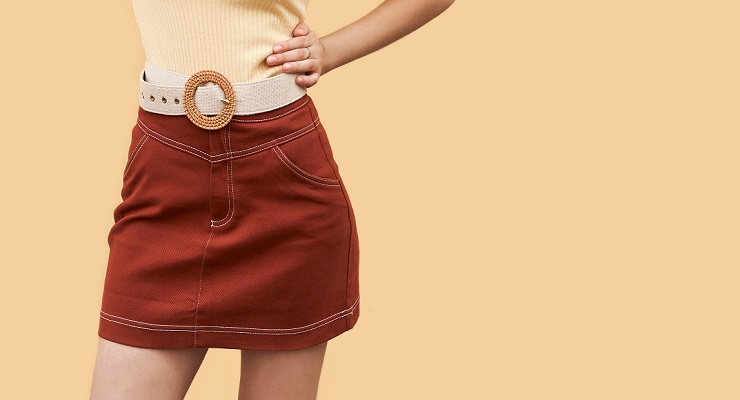
The miniskirt is a mandatory part of any “those were the days” 1960s montage. Somewhere between footage of The Beatles disembarking at JFK Airport and splayed tendrils of white and orange curling through Palm Trees you’ll get a shot of a pixie-cut model with a hemline way above her knees. The miniskirt has become a symbol of the “youthquake” — greater permissiveness in the public square, the liberation of the female body from enforced modesty and passivity, and an explosion of youth-driven counterculture that would define the coming decades.
On a cultural level, of course, much of this is nonsense. As historian Pauline Hastings points out in her talk “The Miniskirt and the Unravelling Rag Trade” — held as part of Melbourne Fashion Week and drawing on research for her PhD — the vast majority of kids in the 1960s, particularly in Australia, didn’t form part of any counterculture movement. They had work in the morning.
As Hastings sketches, what was aimed at young women in the early 1960s was largely “what your mum wears, but smaller”. Gradually, the youthquake found its way to Australian shores, firstly via The Beatles’ visit in 1964 and — more momentously for the purposes of fashion — British model Jean Shrimpton’s then scandalous appearance at Derby day in 1965 wearing a skirt above the knee and no hat. Within days copies of Shrimpton’s dress were appearing in Australian department stores.
The push for greater individuality of clothes and for higher turnover swelled the number of clothes factories, particularly those opening in regional areas, led by financial incentives as the government pushed for decentralisation and tried to keep young people from drifting away from the regions.
Work and production are the focus of Hastings’ talk. By the early 1970s, she tells us, the textile, clothing and footwear industry employed somewhere between 165,000 and 200,000 people (the number of outworkers makes the exact numbers tough to calculate) who were predominantly women and often scattered through the regions.
In interviews, Hastings describes work that was hard and frequently poorly paid, but a source of pride. And it’s crazy what a safety net more or less full employment provides. Parental leave may have been an unimaginable step in the late 1960s (women in the Australian public sector could still be fired for getting married when Shrimpton so scandalised Melbourne in 1965), but if you were an experienced clothes factory worker in the late ‘60s you could quit your job to raise kids and return with very little trouble when you wanted.
Then over the ‘70s and ‘80s protectionism fell away, trade was liberalised and the cheaper labour of the developing world became increasingly available. Local fashion production was diffuse, subdivided and reactive, and soon, almost as quickly as it had sprung up, it collapsed.
So Hastings’ explication of the miniskirt, and the industry that bloomed and withered around it over the course of a mere 20 years, is a glimpse into a vanished world. Broadly, the cultural settings have been retained — the veneration of and aggressive marketing to youth, the sometimes empty nods to certain kinds of social progress. But the material conditions are collapsing: say, the ratio of annual income to house prices veering away from one another for decades, the slow then sudden erosion of job security, the end of regional hubs organised around manufacturing.
One of the major players in 1960s fashion, Maurice C Dowd, was slowly bought up by other companies, and its workforces sent overseas. Its old factory in Warragul is now a community health centre. Hastings closes by noting the symmetry — it’s where the largely female local workforce is now primarily engaged, and the demand is driven by the same generation that caused the building to spring up in the first place.








The mini skirt came to be because under purchase tax rules they became tax free as children clothes. So they became cheaper it was the marketing which was brilliant.
As someone who turned 13 years of age at the end of 1960, I feel that I grew up in one of the most exciting decades in human history. It was marred by one hideous blot which was, of course, the Vietnam War, which thankfully I was not part of, apart from attending many anti-war rallies.
The mini-skirt was part of that excitement and I didn’t have any complaints about it then (or since) and neither did any of my friends (male or female).
The skirts in “Ally McBeal”. like McGuinn & McGuire in Creeque Alley, couldn’t get no higher but that’s what they was aiming at, knickers au go-go.
Pity about everyone getting fat.
And the mini-skirt necessitated the invention of pantyhose. Could have those suspenders and stocking tops showing!
In bitterly cold Britain maybe but here those sweaty things were long abandoned.
This was 50 years ago. Fashions and clothes have changed again many times since. Anyhow thick tights under a very short skirt in a Canberra winter were very welcome. .
Mini-skirts only lasted for 4-5 years. As soon as we’d cut the hems off all our skirts, skirt length dropped to below the knee and a whole new wardrobe was required.
By law or magic that “skirt length dropped”!
Wasn’t there a Kinky song “Deadheaded Follower of Fashion”?
So you ignore fashion?
Only like any other annoying idiocy – totally.
Dedicated Follower of Fashion
Actually “Dedicated Follower of Fashion”. But deadheaded has a certain, perhaps intended, resonance,
…ya think?
Im quietly confident no girls wore shorter school uniforms than the girls at Pt Augusta High School in 1970. No one complained.
Every free trade agreement sells out Australian Workers.